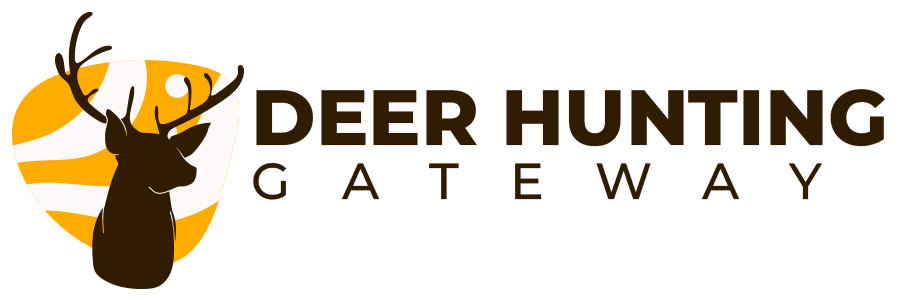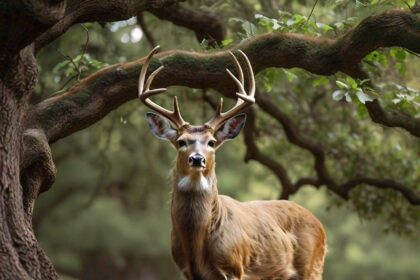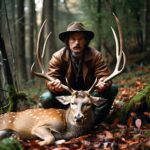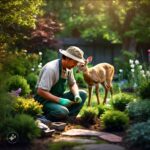The world of nature shows us how deer and domestic animals interact in interesting ways. These interactions can be both beautiful and challenging, especially in areas where humans and wildlife meet.
But by looking into the history, patterns, and effects of deer and domestic animals, we can learn a lot about ungulate relationships. In this article, we will explore the interactions between deer and domestic animals deeply, aiming to change how we think about managing these ruminants and protecting nature.
Different deer (like various antelope) species and domestic animals live together in many places, from farms to backyards. As deer numbers grow, their contact with animals and humans increases. It’s important to understand these relationships to reduce conflicts, stop disease spread, and find ways to manage them well.
History of Deer Farming and Deer Parks
The farming of wild deer and deer grasslands/parks have a long history, dating back to ancient times. In the United Kingdom, deer parks became popular during the Roman era. By 1085-1086, the Domesday Book listed at least 31 parks in Britain.
Over the centuries, the UK saw around 2,000 deer parks. These parks were mainly for hunting by the elite. They existed many deer for this activity.
Origins and Evolution
Wild species, particularly the fallow deer have been moved over different areas of the world for at least 8,000 years. They can now be found on every continent except Antarctica. During the Pleistocene glaciation, their range was very limited, with only a few herds in Turkey.
The Romans brought deer to Europe and the British Isles. By the 11th century, the Normans reintroduced fallow deer to Britain.
Deer farming and deer parks were linked to royalty and the upper classes. Deer meat (venison) was a big part of their diet. The formalized hunts were a favorite activity as native deer were a major source of food among the elite.
Over time, some deer parks became private, while others welcomed the public. Today, deer farming is a small but growing industry in the UK. There are about 300 farms with around 36,000 deer.
The industry has also grown in other countries, like the United States. In 2012, white-tailed deer farming sales reached almost $44 million there.
Deer and Cattle: Spatial and Temporal Interactions
Deer and cattle often live together in the same areas, leading to interesting interactions. Research shows that deer and cattle share the same spaces but mostly stay away from each other to avoid injury to each other. Different deer species tend to leave when they see cattle nearby. This might depend on the deer’s age and sex, with older deer feeling safer around cattle than younger ones.
Age and Sex Differences
A study looked at how different species of deer and cattle interacted in their natural lives over a year. It followed six white-tailed deer (three males, three females) and nine cows with GPS collars. The results showed that deer started to avoid cattle when they were about 50 meters apart.
This study also found that male and female deer behave differently. Female deer and some fawn (baby deer) liked rocky and river areas, while males preferred open clay loam sites. Deer didn’t stay near water or food for a long time, showing that cattle didn’t push them out or make them overuse the land.
Knowing how deer and cattle interact is key to managing them together. By understanding the differences in how males and females deer move and interact, managers can help them and species may live together well.
Interactions Between Deer and Domestic Animals
Many species of deer don’t just interact with cattle; they also connect with pets and humans. These interactions can sometimes cause problems, like damage to property, attacks on pets, and accidents with people. While deer are also susceptible to diseases, they can also spread diseases to domestic animals, which is bad for their health.
Dealing with deer and domestic animals is complex. We need to understand these interactions to keep forests and other ecosystems healthy and reduce conflicts. It’s important to know how to manage these challenges effectively.
Deer-Livestock Conflicts
Deer and domestic animals like cattle, sheep, and goats often fight over food (grass). Deer eat mainly forbs and browse, while livestock eat a variety of plants. This can cause competition and make it hard for deer to survive in the area.
Deer-Pet Interactions
Deer and pets like dogs and cats can sometimes clash. Deer might see pets as threats and attack them. They can also give pets diseases like Lyme disease, which is bad for their health.
Deer-Human Conflicts
Deer can cause problems by entering homes, damaging property, or endangering people. Car crashes with deer are a big worry, causing damage and sometimes hurting people. We need to find ways to keep people safe and protect deer too.
Understanding how deer and domestic animals interact helps us find solutions. We can use things like better habitats, controlling predators, and teaching the public to live with deer. This way, we can all get along better and reduce conflicts.
Impacts on Deer Habitat and Foraging
Domestic animals like cattle affect deer’s home, how they find food and how they breed. Deer change where and when they move to avoid competition. This can break up their living spaces and limit their access to good places to eat and hide.
Competition for Resources
It’s important to understand how deer and domestic animals compete for resources. They often live in the same areas; be it forests and thickets and eat the same plants. This leads to conflicts over food and space.
Domestic animals can change deer’s lives in many ways. For example, because both cattle and deer are herbivores, cattle can eat all the tasty plants, making deer look for new food. This might make deer come closer to people, which can be dangerous for both deer and humans.
- The presence of domestic animals can break up deer habitats, making it hard for them to find good places to eat and rest, especially during mating seasons.
- Deer have to work harder to avoid domestic animals, which takes away from time for other important activities.
- Domestic animals can bring in plants that aren’t native, changing the deer’s home and making it harder for them to find food they like.
Knowing how domestic animals affect deer helps wildlife managers find ways to reduce conflicts. They might manage where domestic animals live, plant native plants, and make safe paths for deer to move through.
Deer Management and Conservation Strategies
Managing deer and conservation needs a look at how deer and domestic animals interact. We must work together to find solutions that help deer, domestic animals, and people. This means thinking about the big picture and what everyone needs.
One important part of managing deer is reducing conflicts with domestic animals. We can do this with fences, managing their living spaces, and controlling diseases. By doing this, we can lessen competition for food and stop zoonotic diseases from spreading.
It’s key to use the latest science and listen to everyone involved in deer management. For example, deer numbers in North America have grown a lot, thanks to hunting rules, moving deer around, proper veterinary care and conservation efforts.
Managing deer also means looking at their value to us. In the U.S. and Canada, people spend a lot on hunting deer. Deer also bring in money through hunting and viewing, but they can cause problems like car crashes and damage to farms.
By planning carefully, we can make sure deer are not bred in captivity but are around for a long time. This helps protect domestic animals and people too. This way, we can make better decisions and meet everyone’s needs.
- Implement fencing and other physical barriers to separate deer and domestic animals
- Manage grassland habitats to provide adequate resources for both deer and domestic animals
- Develop disease control protocols to prevent the spread of diseases between deer and livestock
- Collaborate with stakeholders, including hunters, wildlife enthusiasts, and livestock producers, to develop comprehensive deer management plans
- Conduct regular assessments of deer populations and their impacts to inform management decisions
- Promote sustainable deer hunting practices to maintain healthy deer populations
- Educate the public on the importance of deer management and conservation
Conclusion
The relationship between deer and domesticated animals like cattle is complex and important for wildlife and farming. Studies have shown how these animals interact in space and time. They also look at how they share or avoid each other’s resources.
As the number of deer in the world continues to grow, they face more human threats, like losing their homes to farms. It’s important for experts and leaders to find ways to manage this. They need to balance the needs of deer, domestic animals, and their habitats. This can be done by using science, listening to different views, and trying new ways to manage the land.
Working together and being flexible is key to dealing with deer and domestic animals. We need to understand the many factors that affect them. By doing this, we can help deer thrive, support farming, and keep our ecosystems healthy. This way, both wildlife and people can live well together.








